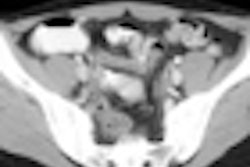
A bill that would require medical imaging facilities to record the radiation dose from any exam that delivers ionizing radiation is scheduled for discussion on the floor of the California Senate today.
Sponsored by Sen. Alex Padilla (D-San Fernando Valley), SB 1237 would require any healthcare facilities that use ionizing radiation to "record the dose of the radiation used during the administration on the radiology film," according to the bill's text.
The bill was introduced on February 19. It is scheduled for what is known as a Senate third reading today, meaning that it's eligible for discussion, said Khaim Morton, a legislative consultant in Padilla's office. "As to whether or not it's going to be taken up today, I'm not sure yet," he said.
 |
| Image shows the back of radiation victim Michael Heuser's head following CT perfusion scanning at Cedars-Sinai Medical Center in Los Angeles. Image courtesy of Eric Bailey, Consumer Attorneys of California, Sacramento. |
On April 21, the first patient to be overexposed at Cedars-Sinai, Michael Heuser, testified to the Senate Health Committee that he had received eight times the normal perfusion dose, or roughly the equivalent of 50,000 chest x-rays, when he was scanned after suffering symptoms of a stroke, according to Padilla's office.
The scans left a four-inch band of bare scalp around his head, Heuser said in a YouTube video prepared by his attorneys. "I ran my hands through my hair, I looked down, and clumps of hair were stuck to my hand," Heuser said.
"If the requirements put forth in Senate Bill 1237 had been law in February 2008, the doctors at Cedars-Sinai would have discovered the excess radiation with the first patient and not have inadvertently overdosed an additional 259 patients, including me," Heuser said in an April 21 press statement on Sen. Padilla's Web site.
"The fact that these overdoses continued for 18 months speaks to the genuine need for protocols and safeguards to prevent overdoses in the future," Padilla said in a statement. "SB 1237 will establish those protocols and safeguards and require that radiation doses be recorded on the scanned images and in a patient's records. This will provide physicians the information they need to track dosage levels and prevent patients from receiving overdoses of radiation."
By Eric Barnes
AuntMinnie.com staff writer
May 24, 2010
Related Reading
Settlement reached in Mad River pediatric CT radiation case, May 24, 2010
JACC special issue tackles radiation dose in cardiac imaging, May 14, 2010
FDA hearings rise above medical radiation rhetoric, March 31, 2010
VC grilled in radiation hearings, March 31, 2010
Radiology gears up for FDA radiation hearings, March 30, 2010
Copyright © 2010 AuntMinnie.com




















